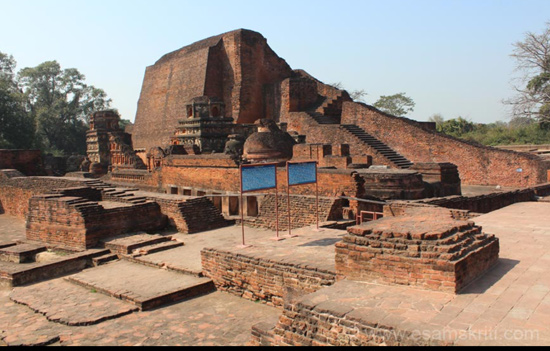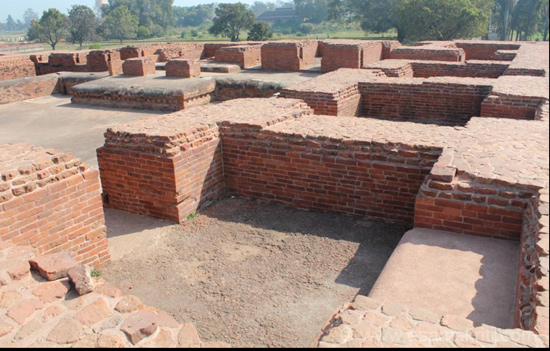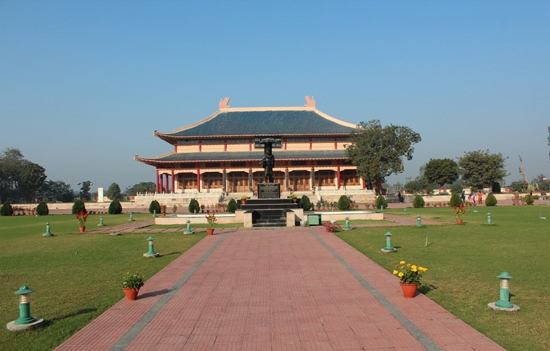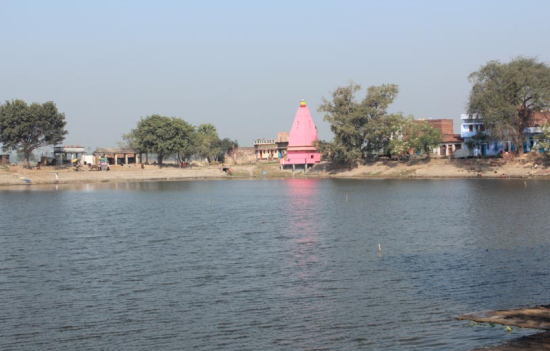- Author Abhay K shares a brief piece based on his book ‘Nalanda: How it Changed the World’.
Though the edifices of Nalanda were largely reduced to mounds and the great monastery ceased to function in the early fourteenth century—its legacy in the development of Science, Medicine, Mathematics, Astronomy, Philosophy, Logic, Grammar, Script, Book Culture, Translation, Language, Literature, Art and Architecture among others endures to this day.
The first Vihara
at Nalanda was founded in the third century BCE by Emperor Ashoka. A standard
architectural plan of the vihara developed as a residential seat of learning
during the Mauryan period and attained a regular form at Nalanda Mahavihara,
which is considered to have inspired the courtyard structure of colleges and
universities across Europe, including the quads and courts of Oxford and Cambridge
University. (Read Note 1)
The evolution of
Nalanda from a Vihara founded in the third century BCE into a Mahavihara with a
well laid out plan with multiple monasteries, a developed infrastructure, large
endowments, a walled residential campus, multiple rectangular monasteries,
international students, where a variety of disciplines, including secular
disciplines, were taught by the best scholars of their time, is how the idea of
a university evolved in its true sense over centuries and spread to Central
Asia, Europe and the rest of the world.
Great scholars such as Nagarjuna, Vasubandhu, Santaraksita and Kamlasila at Nalanda Mahavihara contributed greatly to advancing the recursive argument method—an argument followed by sub-arguments, which led to the development of the medieval scientific method. This approach spread to different parts of the world, including Central Asia, and eventually reached to the Arab world and Europe.
Aryabhata, who is regarded as the ‘father of Indian mathematics’, was the most prominent mathematician at the Nalanda Mahavihara in the sixth century CE. The author of his seminal book Aryabhatia, he was
the first mathematician to assign zero as a digit, a revolutionary concept,
which simplified mathematical computations and gave birth to concepts which
later became known as algebra and calculus.
Brahmgupta later
improved the work of Aryabhata and wrote Brahmasphuṭasiddhanta, which was
translated into Arabic in the eighth century and became widely known as Sindhind, which in turn introduced Indian numbers, algebra, calculus, algorithm and Indian astronomy to Europe. Nalanda’s impact in the field of mathematics and astronomy was particularly significant in China.
Gautama Siddhartha headed the Indians to rise to eminence at this time was the celebrated Gautama Siddhartha, the Bureau of Astronomy of China between 665 and 698. ‘It was his job to regulate the official calendar used in government and to interpret astral omens and other heavenly phenomena for the Empress Wu Zetian. Gautama was the first of three generations of his family who successively held the position.’
Tantric Buddhism
that developed at Nalanda became a major force in China in the seventh and
eighth centuries and had followers among Chinese intellectuals of the highest
standing. Since many Tantric scholars had a deep interest in mathematics
(perhaps connected, at least initially, with Tantric fascination with numbers),
Tantric mathematicians had a significant influence
on Chinese mathematics as well. Chinese Tantric Buddhist monk I-Hsing or Yi Xing (672–717 ce), the greatest Chinese astronomer and mathematician of his time, acquired great expertise in Indian writings on mathematics and astronomy developed at Nalanda.
Nalanda
contributed to the development and evolution of two major Mahayana Buddhist
philosophies viz. Madhyamaka and Yogacara. The continuous engagement with
Yogacara for centuries at the Mahavihara led to the evolution of a specialized
school known as Vajrayana or Tantrayana, based on the principles of Yogacara
philosophy.
A new philosophy, synthesizing Madhyamaka and Yogacara, was developed at Nalanda Mahavihara by Santaraksita, which is known as Yogacara–Madhyamika.
 Sariputra Stupa. 2014.
Sariputra Stupa. 2014.
Nalanda Mahavihara
played a key role in the spread of these Nalanda-grown philosophies across
South, Central, East and South-East Asia, shaping the cultural and religious
perspective of the people in the countries of these regions.
By the fifth century CE, Nalanda had become a major centre
of art. Artworks produced at Nalanda had features of both Mathura and Sarnath
with some local touch, which later evolved into its own distinct Nalanda School
of Art during the Pala period by the eighth century CE and had a significant
influence on the art of the east and Southeast Asian countries.
The idea of making
three-dimensional mandalas evolved with the Tantric Buddhist principles
developed at Nalanda Mahavihara as part of the Vajrayana philosophy, which was
used to build the Buddhist stupas of Kesariya in Bihar and Borobudur in Java, the world’s largest Buddhist monument.
The acharyas of
Nalanda enriched Sanskrit language by composing their works in Sanskrit, which
included philosophical texts, compositions on Buddhist logic and ethical
manuals in pure and Panini Sanskrit, and stotras, mahatmyas, dharanis, tantras
and sadhnas in hybrid Sanskrit.
The great
tradition of copying sutras at Nalanda Mahavihara and translating them into
various languages enriched the language, literature and culture of many
countries over centuries. The culture and language of Tibet is a living testimony
to this tradition.
 Monks quarters. 2014.
Monks quarters. 2014.
The Tibetan
scholar Thonmi Sambhota, who studied at Nalanda Mahavihara, devised scripts for the Tibetan language based on the
Devanagari and Kashmiri scripts.
Eighty-four
Siddhas of Nalanda Mahavihara, along with the Jain saints, played a pivotal
role in the development of Apabhramsa poetry from the eighth to the thirteenth
century, contributing to new poetic forms such as doha, chaupai and paddhari
among others.
Nalanda played a
central role in developing the art of manuscript
writing, illustration, preservation and copying. Thus, manuscript
writing, copying and preservation culture at Nalanda accelerated the transition
from an oral culture to a writing culture worldwide.
The world’s first printed book is The Diamond Sutra, a
part of Prajnaparamita Sutra,
believed to be written by Nagarjuna at Nalanda. The Dhamma Wheel, in which the
sacred texts are mechanically revolved, was invented at Nalanda. Medicine
practice at Nalanda greatly impacted the medical tradition of East Asia,
especially China, including advanced ophthalmology practised at Nalanda, which
was introduced to Tang China.
The Rasaratnakara, composed by Nagarjuna in
the early centuries CE, is considered the first treatise on Indian alchemy.
Nalanda’s excellence and best practices in medicine, ophthalmology, alchemy and other health sciences were embraced in Tibet, Nepal, China, Korea, Japan, Mongolia and many parts of the world.
The earliest
mention of Hatha yoga is found in the Buddhist tantric texts of Vajrayana
school, which developed at Nalanda Mahavihara, eighth century onwards. The
evolution of Hatha yoga over centuries led to democratization of yoga,
liberating it from religious and ritualistic dimensions and became the reason
for its acceptance and popularity across the world.
The life and
ideals of Jesus Christ have a close parallel with Buddha taking birth as
Bodhisattvas and sacrificing his own life to save others in the Jataka Tales.
The scholastic tradition at Nalanda developed by Nagarjuna popularized the view
that these Bodhisattvas were at par with the historical Buddha himself. Several
historians believe that there is a real possibility that Buddhism influenced
the early development of Christianity.
 Hiuen Tsang Memorial Nalanda. 2014.
Hiuen Tsang Memorial Nalanda. 2014.
Though Nalanda
Mahavihara ceased to exist in the early fourteenth century, its great fame
continued to live and inspire the establishment of monasteries and educational
institutions named after it. The legend of Nalanda lives on and has gathered
pace in recent years.
Nava Nalanda
Mahavihara was founded in 1951 in Nalanda, Bihar and attached to it is a
memorial hall dedicated to the great Chinese traveller Xuanzang, which was
completed in 1984. Karma Shri Nalanda Institute was founded in 1981 in Sikkim
and Nalanda Open University was established in 1987 at Nalanda, Bihar. In 2010,
Nalanda University was established in Rajgir.
Nalanda’s reputation in foreign lands led to the establishment of several institutions named after it. Nalanda Gedige in Sri Lanka dates to the eighth century, when Nalanda Mahavihara was still functioning.
 Surya Kund Nalanda. The Surya Temple has a murti of Buddha. 2014.
Surya Kund Nalanda. The Surya Temple has a murti of Buddha. 2014.
Phenpo Nalendra, a Tibetan Nalanda Monastery was founded in 1435 in the Phen-yul valley, to the north-east of Lhasa, by the monk-scholar Rongton Sheja Kunrig (1347–1449). It housed approximately 700 resident monks and thousands of visiting monks and has branches in various parts of Tibet.
In Europe, a
Nalanda Monastery was founded at Lavaur, about forty kilometers from Toulouse,
France, in 1981, by Lama Zopa Rinpoche and Lama Thubten Yeshe.
In 1989, Nalanda
Buddhist Centre, Brazil, was created as a tribute to Nalanda Mahavihara. It
tried to follow the practices of the original monastery. In 1999, Nalandarama
Retreat Centre, Brazil became the first Theravada centre in South America to
provide forest-based incentive meditation.
Nalanda College of
Buddhist Studies was founded by Suwanda H.J. Sugunasiri in 2000 in Toronto,
Canada.
The International
Buddhist College (IBC), founded in 2000 in Hatyai, the largest city in Southern
Thailand, is built like Nalanda, to bring together various Buddhist traditions
and to promote better understanding of each other.
Nalanda Institute,
founded in 2007 on the southern outskirts of Kuala Lumpur, Malaysia, was
modelled after Nalanda Mahavihara to promote Buddhist studies in the country.
Nalanda Institute
for Contemplative Science was founded in the USA by Joe Loizzo, a psychiatrist
in 2007, who was inspired by the ancient university of Nalanda. It was
conceptualized during his research in contemplative science at Columbia
University and Weill Cornell Medical College from 1996.
As evident from these examples of Nalanda’s growing footprints in Asia, Europe, North and South America and Australia, it is clear that the repute of Nalanda is going to grow in times to come. Nalanda’s age old tradition of imparting knowledge, wisdom and kindness can help humanity in overcoming hatred, anger, frustration, greed and in achieving inner and outer peace.
To buy book online
Nalanda: How it changed the world
Editor Note 1 “Nalanda was the place
of birth of Sariputra, one of the famous disciples of Buddha. As per the ASI
board, Nalanda Mahavir was founded by Kumaragupta (413-455 a.d.) of the great
Gupta dynasty, Harshvardhana of Kanauj (606-647) and the Pala Kings of East
India (8-12th century). Pala ruler Mahipala (988 A.D.) repaired the Nalanda.” Read
more Here
To see album of
Nalanda ruins
Also read
1. Author Interview HT–Nalanda
was an international melting pot
2. What happened to
Universities of Nalanda, Vikramsila, Valabhi, Odantapura
3. Nalanda University
Rajgir album
4. Ramayana in
Thailand
5. Lord Indra in
Buddhism
6. Why did Buddhism
vanish from India
7. Bodh Gaya Temple
album
8. How Hindu and
Buddhist strains are intertwined in Thailand, Cambodia and Japan
9. Origins of Yoga
10. Yoga’s contemporary gifts to the Western World
11. To visit AUTHOR WEBSITE